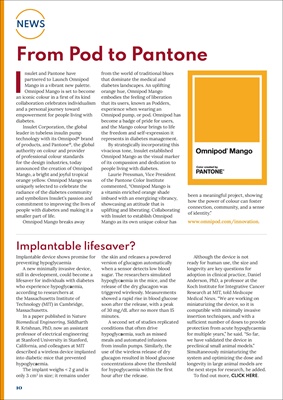
10
NEWS
Implantable lifesaver?
Implantable device shows promise for
preventing hypoglycaemia
A new minimally invasive device,
still in development, could become a
lifesaver for individuals with diabetes
who experience hypoglycaemia,
according to researchers at
the Massachusetts Institute of
Technology (MIT) in Cambridge,
Massachusetts.
In a paper published in Nature
Biomedical Engineering, Siddharth
R. Krishnan, PhD, now an assistant
professor of electrical engineering
at Stanford University in Stanford,
California, and colleagues at MIT
described a wireless device implanted
into diabetic mice that prevented
hypoglycaemia.
The implant weighs < 2 g and is
only 3 cm3 in size; it remains under
the skin and releases a powdered
version of glucagon automatically
when a sensor detects low blood
sugar. The researchers simulated
hypoglycaemia in the mice, and the
release of the dry glucagon was
triggered wirelessly. Measurements
showed a rapid rise in blood glucose
soon after the release, with a peak
of 30 mg/dL after no more than 15
minutes.
A second set of studies replicated
conditions that often drive
hypoglycaemia, such as missed
meals and automated infusions
from insulin pumps. Similarly, the
use of the wireless release of dry
glucagon resulted in blood glucose
concentrations above the threshold
for hypoglycaemia within the first
hour after the release.
Although the device is not
ready for human use, the size and
longevity are key questions for
adoption in clinical practice, Daniel
Anderson, PhD, a professor at the
Koch Institute for Integrative Cancer
Research at MIT, told Medscape
Medical News. "We are working on
miniaturizing the device, so it is
compatible with minimally invasive
insertion techniques, and with a
sufficient number of doses to provide
protection from acute hypoglycaemia
for multiple years," he said. "So far,
we have validated the device in
preclinical small animal models."
Simultaneously miniaturizing the
system and optimizing the dose and
longevity in large animal models are
the next steps for research, he added.
From Pod to Pantone
Insulet and Pantone have
partnered to Launch Omnipod
Mango in a vibrant new palette.
Omnipod Mango is set to become
an iconic colour in a first of its kind
collaboration celebrates individualism
and a personal journey toward
empowerment for people living with
diabetes.
Insulet Corporation, the global
leader in tubeless insulin pump
technology with its Omnipod® brand
of products, and Pantone®, the global
authority on colour and provider
of professional colour standards
for the design industries, today
announced the creation of Omnipod
Mango, a bright and joyful tropical
orange yellow. Omnipod Mango was
uniquely selected to celebrate the
radiance of the diabetes community
and symbolizes Insulet's passion and
commitment to improving the lives of
people with diabetes and making it a
smaller part of life.
Omnipod Mango breaks away
from the world of traditional blues
that dominate the medical and
diabetes landscapes. An uplifting
orange hue, Omnipod Mango
embodies the feeling of liberation
that its users, known as Podders,
experience when wearing an
Omnipod pump, or pod. Omnipod has
become a badge of pride for users,
and the Mango colour brings to life
the freedom and self-expression it
represents in diabetes management.
By strategically incorporating this
vivacious tone, Insulet established
Omnipod Mango as the visual marker
of its compassion and dedication to
people living with diabetes.
Laurie Pressman, Vice President
of the Pantone Color Institute
commented, "Omnipod Mango is
a vitamin enriched orange shade
imbued with an energizing vibrancy,
showcasing an attitude that is
uplifting and liberating. Collaborating
with Insulet to establish Omnipod
Mango as its own unique colour has
been a meaningful project, showing
how the power of colour can foster
connection, community, and a sense
of identity."
www.omnipod.com/innovation.